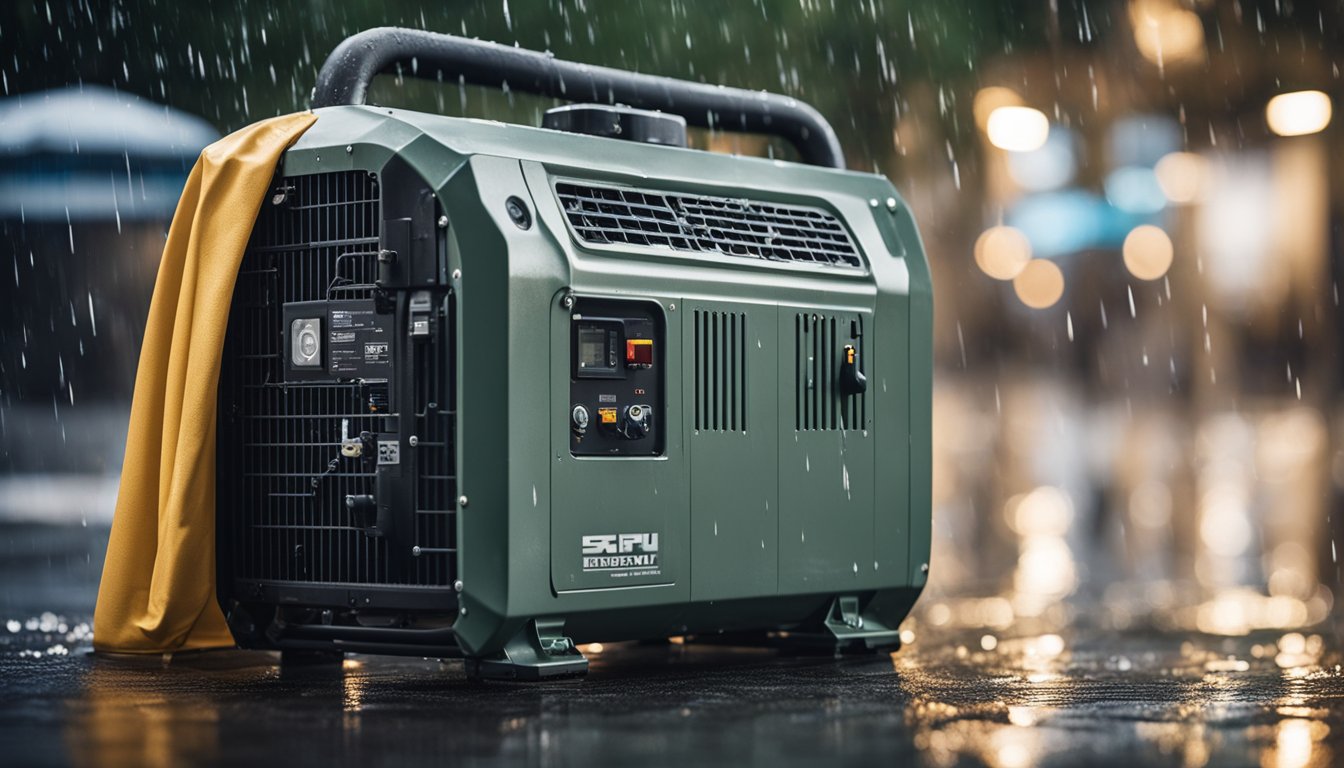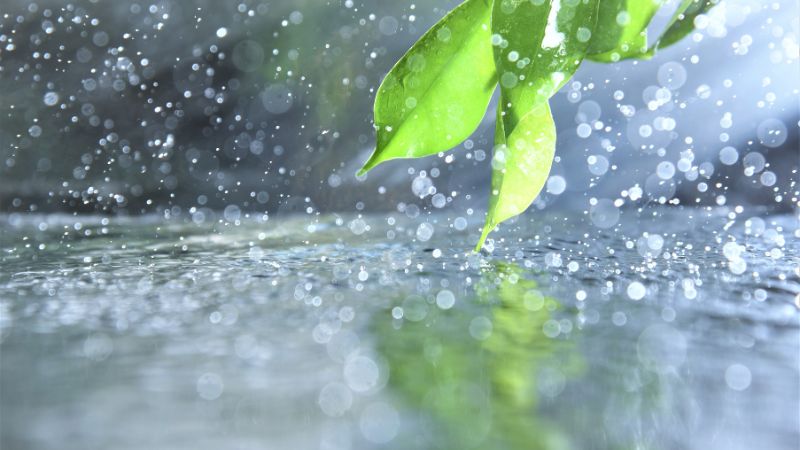
Generators are essential when a power outage occurs. But can you use a generator in the rain?
The good news is that you can run your portable generator in the rain, but only with proper protection like a generator cover or tent to keep it safe from direct water contact.
This guide will explore the risks of running a generator in the rain, safety precautions to take, and tips for maintenance to ensure your generator runs smoothly.
Risks of Operating a Generator in the Rain
Operating a portable generator in rainy conditions creates several dangerous situations that every generator owner should know about. These risks go beyond just getting equipment wet and can have serious safety consequences.
Electric Shock Risks
Water significantly increases the risk of electric shock when using generators.
Rain creates a conductive path that can carry electricity from the generator to you. This happens because water lowers electrical resistance, making it easier for current to flow where it shouldn’t.
Your wet hands, puddles under your feet, or even high humidity can create paths for electricity to travel. Standing in a puddle while touching a wet generator could result in a severe or fatal shock.
Wearing rubber gloves and shoes with rubber soles are necessary.
Short Circuit Potential
When water gets into electrical components, your generator can create short circuits. This happens when water bridges connections that should remain separate.
Short circuits in generators can cause:
- Sudden power loss during critical situations
- Sparking that could ignite nearby flammable materials
- Damage to devices connected to your generator
Water intrusion often happens at connection points, outlets, or control panels. These areas are particularly vulnerable as they have openings where water droplets can enter.
Most consumer generators aren’t designed with proper sealing to prevent water from reaching sensitive electrical components inside.
Generator Damage Risks
Rain exposure can cause lasting damage to your generator.
- Metal components: Water can rust internal metal components, which in turn leads to corrosion of electrical connections and causes electrical system damage over time.
- Engine Parts: Water entering fuel systems can prevent proper combustion or cause fuel contamination.
- Control panel and outlets: Even small amounts of moisture can gradually degrade these components, shortening your generator’s lifespan and reliability.
How to Protect a Generator in the Rain?

Protecting your generator in the rain is essential for safety and equipment longevity. Follow these right safety precautions to prevent electrical hazards.
Placing Generator Safely
Proper placement is critical for safely operating generators in rain. Never place your generator directly in rainfall or standing water.
Important placement tips:
- Keep generator at least 20 feet from your home
- Place on dry, level ground
- Ensure exhaust points away from buildings
- Never use inside garages, carports, or covered porches
- Avoid DIY solutions like tarps or plastic bags that can trap deadly carbon monoxide or cause overheating.
Using Canopies and Covers
A simple solution for running a generator in the rain is using a high-quality generator cover. These covers are designed to shield your generator from direct rainfall while allowing proper ventilation.
When choosing a cover, look for:
- Weather-resistant materials like polyester with waterproof coating
- Proper airflow design to prevent overheating and carbon monoxide buildup
- Secure attachment points to withstand windy conditions
These specialized covers allow you to operate your generator safely during a downpour or snow. Inverter generators are typically smaller, making them easier to shield with generator canopies or covers
Waterproof Generator Enclosures
For more permanent protection, consider a waterproof generator enclosure. These structures provide complete shelter while addressing ventilation needs that prevent dangerous carbon monoxide buildup.
Effective enclosures include:
- Pre-made generator houses with proper ventilation
- DIY enclosures using weather-resistant materials
- Steel or plastic housings with lockable doors
When building or buying an enclosure, ensure it has:
- Ventilation openings positioned away from rain direction
- A minimum 3-foot clearance from walls or structures
- Weather-sealed electrical connections
Never place an enclosure against your home or in enclosed spaces like garages. The enclosure should be situated at least 20 feet from your house with the exhaust pointing away from any structures.
Ground Fault Circuit Interrupters (GFCIs)
GFCIs are crucial safety devices that quickly cut power when they detect current leakage, which commonly happens in wet conditions. They act as a vital safeguard when operating generators in rainy weather.
You can add GFCI protection in several ways:
- GFCI outlets installed on generator panels
- GFCI extension cords for connecting appliances
- Portable GFCI adapters that plug into standard outlets
When using GFCIs, make sure to:
- Test them monthly by pressing the “test” button
- Keep connections elevated and away from puddles
- Replace any damaged cords immediately
Even with GFCI protection, never handle electrical connections with wet hands. Always disconnect power before making connections and ensure all plugs are fully seated and locked into their outlets to prevent moisture intrusion.
Tips for Generator Maintenance in Adverse Weather
Keeping your generator in top shape during bad weather can save you from unexpected power failures. These tips can help you safely operate your portable generator in the rain!

Regular Inspection and Upkeep
Check cords and cables often for any signs of damage or fraying, especially before using your generator in wet conditions. Damaged wires can create serious safety hazards.
Clean your generator regularly to remove dirt, debris, and moisture that can harm internal components. Pay special attention to the air filter, as it can get clogged more quickly in damp conditions.
Test your generator monthly, even when you don’t need it. This helps identify any issues before an emergency happens. Run it for about 30 minutes to keep all parts in working order.
Check these parts before each use:
- Fuel level and quality
- Oil level and condition
- Battery connections
- Air intake vents
Proper Storage Solutions
Cover your generator when not in use with a specially designed generator tent or canopy. These covers are made to protect from rain while allowing proper airflow and heat dissipation.
Never store your generator directly on wet ground. Use a platform or generator stand to keep it elevated and dry. This prevents moisture from seeping into the electrical components.
When storing for extended periods, drain all fuel or add a fuel stabilizer. This prevents fuel deterioration that can damage your generator’s engine over time.
Frequently Asked Questions
What’s the deal with generator tents and do they actually work?
Generator tents actually work quite well when used correctly. They’re specifically designed to shield generators from direct rainfall while still allowing proper airflow.
Most quality generator tents are made from fire-resistant materials that won’t catch fire from the heat. They attach directly to your generator, so they won’t blow away in windy conditions.
If it’s snowing, is it still cool to use a generator outside?
Yes, you can run your generator in snowy conditions, but you need to take extra precautions. Snow can block ventilation and exhaust ports if allowed to build up.
A generator tent or cover becomes even more important in snow to prevent accumulation on the machine itself. Just like with rain, never bring your snowy generator indoors.
Running a generator under a covered porch – yay or nay?
This is generally a nay. Even though your porch might seem like a perfect spot to keep your generator dry, it’s too close to your living space.
Carbon monoxide can build up under porches and find its way into your home. The noise and vibration could also damage your porch structure over time.
